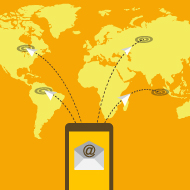October 5, 2015 |
0 Comments
 Simple Mail Transfer Protocol
Simple Mail Transfer Protocol (
SMTP, for short) is techno-speak for a set standard of electronic transmission of information via email and other means that was established and defined in 1982. For normal people, SMTP is behind the scenes of many online interactions like sending and receiving email, communicating via instant messaging services and posting or reading blogs and other media. This type of protocol helps to make sure content that is broken down for electronic transmission is still readable when it is delivered and reassembled.
Standards like Simple Mail Transfer Protocol enable the smooth transference of digital messages. Ensuring the uniformity of messages helps to prevent fatal errors, lost data and other technological difficulties. SMTP makes it possible to send messages from one host or address to another. For instance, if Google, Microsoft or any other provider of email and messaging services each used different electronic languages and standards to control the configuration and manipulation of information, it would be quite chaotic to send an email from
"[email protected]" to
"[email protected]". The potential for data corruption and degradation is astronomical. The implementation and acceptance of SMTP as an internet-wide norm prevents the chaos and makes communication between providers - and even countries - possible and usually seamless.

As explained above, SMTP is essential to email users, clients, and servers, especially. With the transmission of the first email in 1971, the need to streamline the process was realized. Over the following decades, technology and programming languages have improved to increase the efficiency of online communication. The ability to convert digital documents, pictures and videos from user-friendly views to binary codes to travel over waves and wires - and back again - requires uniform procedures and formats to ensure success.
Since the inception of instant messaging and various forms of digital communication around the 1960s, standards and protocols have experienced creation, obsoletion and evolution. SMTP and its successor,
Extended SMTP, or
ESMTP, an expanded edition of SMTP released in 1995, are both examples of that evolution and creative expansion. This enhancement allowed for the increased inclusion of extensions supported by servers, offering more flexibility and manageable means of data control by both clients and servers.
For most users, SMTP is a foreign concept, and many people have no idea what it is or what it does. Like many things of import and value in the online and technological arenas, this essential component of the ever-increasing world of digital communication is unknown, if not unappreciated.
Mikel Smith
Network Server Engineer
Mikel is an expert in network security management and computer systems. He is also an ecommerce project management specialist with experience in developing small to medium web-based systems for business. He loves to travel and fishing during his spare time.
 Simple Mail Transfer Protocol (SMTP, for short) is techno-speak for a set standard of electronic transmission of information via email and other means that was established and defined in 1982. For normal people, SMTP is behind the scenes of many online interactions like sending and receiving email, communicating via instant messaging services and posting or reading blogs and other media. This type of protocol helps to make sure content that is broken down for electronic transmission is still readable when it is delivered and reassembled.
Simple Mail Transfer Protocol (SMTP, for short) is techno-speak for a set standard of electronic transmission of information via email and other means that was established and defined in 1982. For normal people, SMTP is behind the scenes of many online interactions like sending and receiving email, communicating via instant messaging services and posting or reading blogs and other media. This type of protocol helps to make sure content that is broken down for electronic transmission is still readable when it is delivered and reassembled. As explained above, SMTP is essential to email users, clients, and servers, especially. With the transmission of the first email in 1971, the need to streamline the process was realized. Over the following decades, technology and programming languages have improved to increase the efficiency of online communication. The ability to convert digital documents, pictures and videos from user-friendly views to binary codes to travel over waves and wires - and back again - requires uniform procedures and formats to ensure success.
As explained above, SMTP is essential to email users, clients, and servers, especially. With the transmission of the first email in 1971, the need to streamline the process was realized. Over the following decades, technology and programming languages have improved to increase the efficiency of online communication. The ability to convert digital documents, pictures and videos from user-friendly views to binary codes to travel over waves and wires - and back again - requires uniform procedures and formats to ensure success.